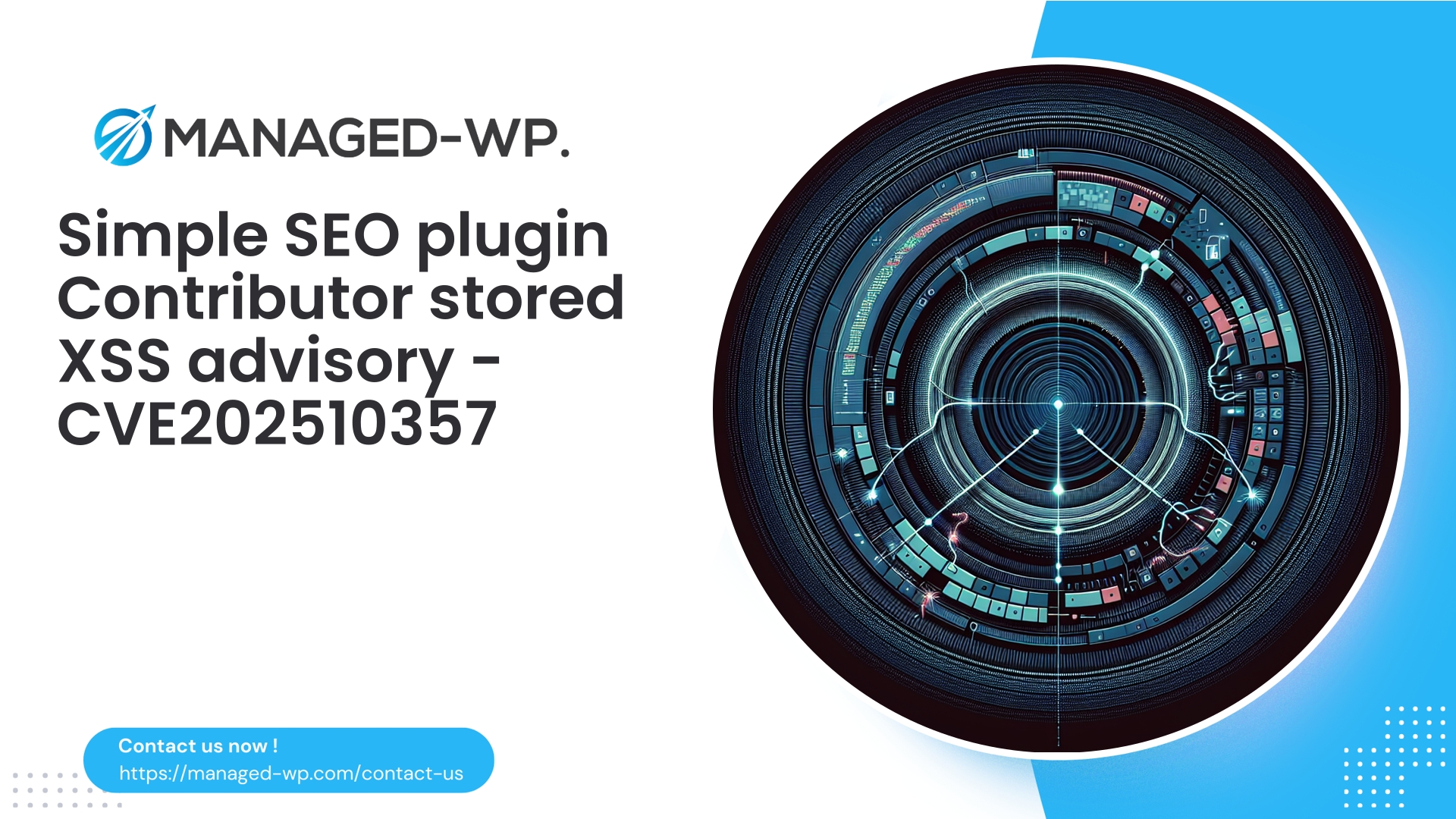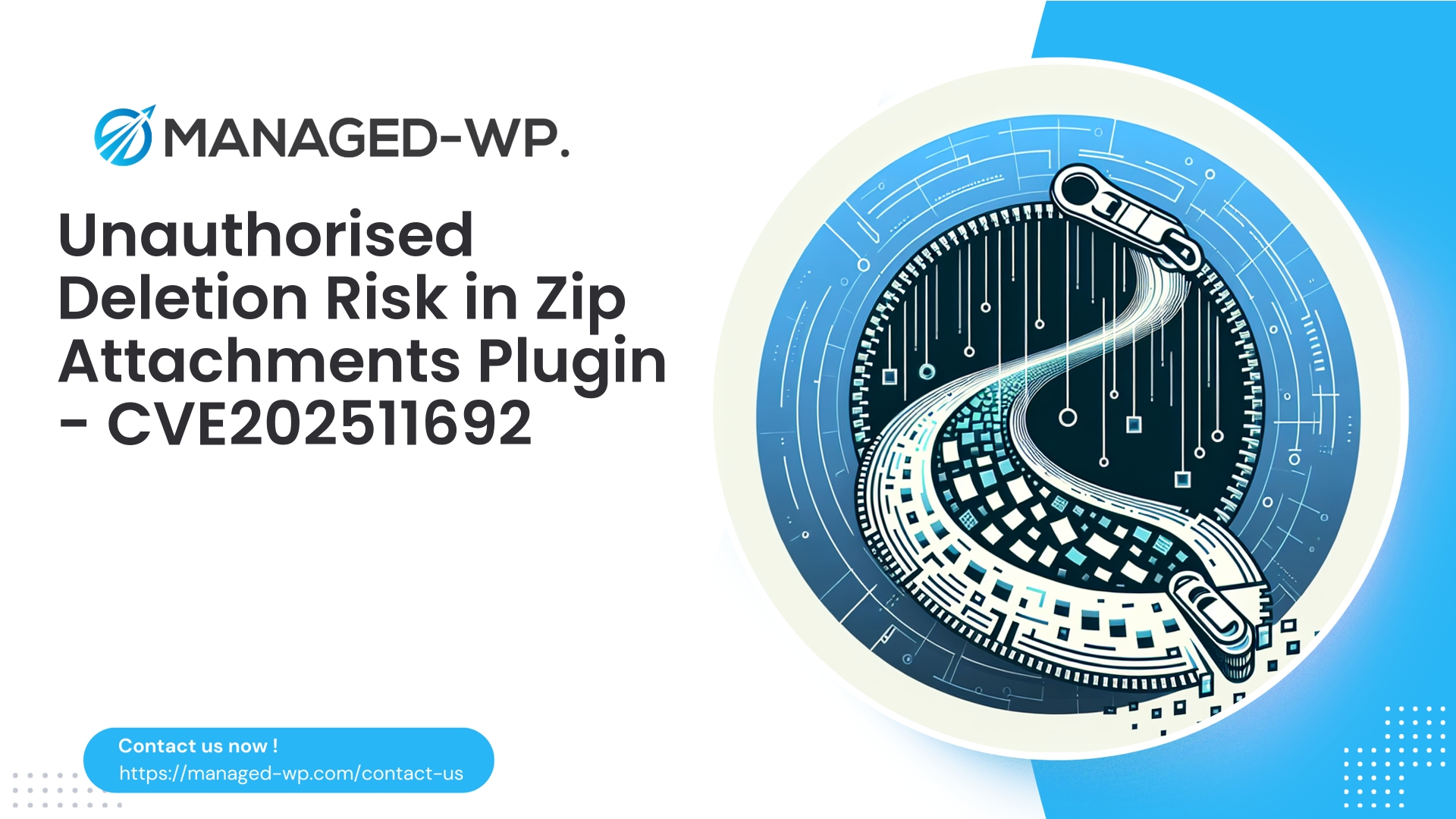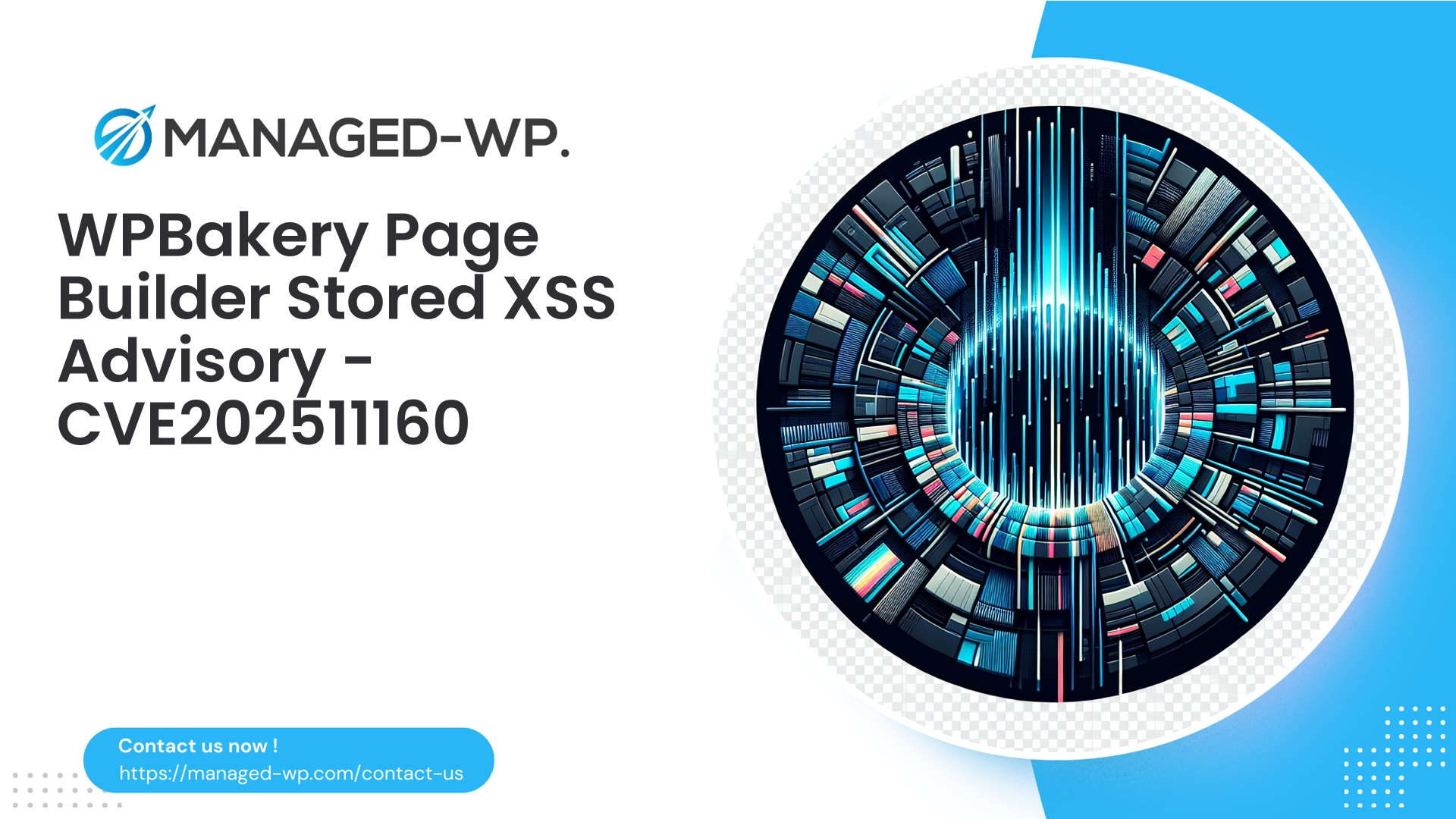| 插件名称 | 简易SEO |
|---|---|
| 漏洞类型 | 存储型XSS |
| CVE编号 | CVE-2025-10357 |
| 紧急 | 低的 |
| CVE 发布日期 | 2025-10-15 |
| 源网址 | CVE-2025-10357 |
Simple SEO 插件(版本低于 2.0.32)——贡献者存储型 XSS 漏洞(CVE-2025-10357):WordPress 网站所有者的重要指南
发布日期: 2025年10月15日
作者: 托管式 WordPress 安全专家
本安全公告详细介绍了 Simple SEO 插件中发现的已披露存储型跨站脚本 (XSS) 漏洞,该漏洞已在 2.0.32 版本中修复 (CVE-2025-10357)。我们的团队提供了全面的分析,涵盖了此安全漏洞的性质、风险范围、利用场景、检测方法以及推荐的缓解策略。此外,我们还解释了像 Managed-WP 这样的托管式 WordPress Web 应用程序防火墙 (WAF) 服务如何在您部署补丁和修复环境的同时提供实时保护。
我们的方法以美国网络安全最佳实践和 WordPress 安全实践经验为基础,专注于提供清晰、可操作的情报,帮助 WordPress 网站所有者快速减少攻击面,而无需使用不必要的术语。
执行摘要
- 漏洞: Simple SEO 插件 2.0.32 之前的版本存在存储型跨站脚本攻击 (XSS) 漏洞。
- CVE标识符: CVE-2025-10357。
- 需要权限: 贡献者角色或更高角色。拥有发帖权限的非管理员用户可以利用这一点。
- 影响: 持久型 XSS — 恶意脚本代码会被保存并在查看受影响内容的用户(包括管理员)的浏览器中执行。
- 严重程度: 供应商将其优先级评为低(CVSS 评分 6.5),但实际风险因站点配置和用户角色而异。
- 补救措施: 立即将 Simple SEO 升级到 2.0.32 或更高版本。
- 临时保护措施: 应用 WAF 规则来阻止 XSS 有效载荷、限制贡献者权限以及扫描/删除存储内容中的恶意脚本。
为什么这种漏洞需要您关注
乍一看,需要贡献者权限的存储型 XSS 攻击似乎风险不大,因为贡献者没有管理员权限。然而,存储型 XSS 攻击具有持久性:注入的脚本保存在插件元数据字段中,并在管理员或编辑视图中渲染时执行。因此,当网站管理员或编辑浏览受影响的页面(例如文章编辑器或 SEO 预览)时,他们可能会在不知情的情况下触发恶意代码,这些恶意代码会利用他们的会话上下文执行。
利用此漏洞的攻击者可以:
- 利用管理员会话执行未经授权的管理操作。
- 收集未受到安全标志适当保护的身份验证令牌和 cookie。
- 部署针对特权用户的钓鱼攻击和重定向攻击。
- 通过程序化方式提交表单来建立后门或提升权限。
影响程度取决于您网站的用户工作流程、安全标头(CSP、Cookie 标志)以及贡献者角色的信任模型。如果不加以解决,此漏洞将造成严重的安全威胁。
了解存储型 XSS
存储型跨站脚本攻击(Stored Cross-Sisk,STS)是指恶意输入被保存到持久存储(例如数据库字段)中,并在之后未经处理的情况下随页面输出。这与反射型跨站脚本攻击(reflected XSS)不同,后者依赖于单个请求。在本例中,由于输入清理和转义不足,Simple SEO 的元数据字段容易受到贡献者的注入攻击。
高风险地点
- 运行 Simple SEO 版本早于 2.0.32 的网站。
- 网站授予半可信用户(客座作者、客户、附属机构)贡献者或更高角色。
- 多作者或会员制网站,未经核实的用户提交内容。
- 管理员或编辑经常在控制面板中预览投稿人内容的网站。
- 缺乏健全的安全标头和 Cookie 保护的网站。
如果您的设备存在上述任何情况,则需要立即进行处理。
利用场景
- 恶意访客作者将 JavaScript 注入到 SEO 描述中,当管理员打开相应的编辑器时,该 JavaScript 就会运行,从而触发未经授权的帐户创建。
- 贡献者存储的脚本会将管理员会话令牌泄露到外部服务器,从而实现对网站设置的远程操控。
- 注入的代码会显示凭据窃取叠加层,登录管理员可以看到这些叠加层。
- 存储的脚本会发起后续攻击,例如通过易受攻击的管理端点安装 PHP 后门。
由于脚本是在管理员的浏览器中以管理员的权限执行的,因此后果可能会迅速升级,超出最初的漏洞范围。
立即采取的缓解措施(前 48 小时)
- 升级: 立即将 Simple SEO 更新至 2.0.32 或更高版本。
- 部署 WAF 保护: 启用托管或现有 Web 应用程序防火墙,并设置针对存储的 XSS 有效负载的规则。
- 限制贡献者权限:
- 暂时禁用或限制您无法完全信任的贡献者。
- 防止不受信任的用户发布内容,管理员会经常进行预览。
- 扫描数据库: 在文章内容和元数据字段中查找可疑的脚本标签和事件处理程序属性。
- 隔离和消毒: 隔离受影响的条目,然后小心地从数据库中删除或清理它们。
- 审计管理会话: 检查管理员最近的登录记录,并根据需要轮换凭据。
- 备份: 在进行任何破坏性更改之前,请务必做好全面备份。
- 监控日志: 密切监控网页和应用程序日志,查找异常或可疑请求。
妥协的迹象
- 内容或元数据中出现意外的 JavaScript(例如, , onerror=, javascript:).
- 未经授权的管理员帐户或权限提升。
- 可疑的定时发布帖子或 cron 作业。
- 与不熟悉的外部域建立出站连接。
- 管理员在使用后端内容编辑器时遇到重定向、弹出窗口或异常行为。
- 近期出现无法解释的文件修改。
使用恶意软件扫描器和文件完整性监控来调查潜在的 Web Shell 和其他痕迹。
确认漏洞利用后进行网站清理
- 将您的网站置于维护模式,以避免进一步攻击。
- 创建文件和数据库的取证快照,以便后续分析。
- 对插件、主题和 WordPress 核心进行全面更新。
- 从数据库中移除注入的脚本——与其彻底删除,不如采取安全的清理方式。
- 审核所有用户,删除未经授权的管理员,并重置特权用户凭据。
- 扫描并删除可疑的文件系统文件,特别是上传文件中的 web shell。
- 检查并清除攻击者注入的计划任务。
- 对所有特权账户强制执行强身份验证和双因素身份验证(2FA)。
- 如有需要,恢复干净的备份,并在修复后严格测试环境。
- 继续密切监控日志和网络流量。
如果不确定,可以考虑聘请专业的事故响应公司。
技术检测和数据库查询示例
运行查询前务必执行完整的数据库备份。
-- 查找内容中包含脚本标签的文章 SELECT ID, post_title, post_author, post_date FROM wp_posts WHERE post_content REGEXP '(?i) ]'; -- 检查 postmeta 中是否存在类似脚本的有效负载 SELECT post_id, meta_key, meta_value FROM wp_postmeta WHERE meta_value REGEXP '(?i)(
WP-CLI 可以协助进行扫描:
wp db 查询“SELECT ID, post_title FROM wp_posts WHERE post_content LIKE '%'
检查用户元数据中是否存在恶意脚本:
SELECT user_id, meta_key, meta_value FROM wp_usermeta WHERE meta_value REGEXP '(?i)(
在进行清理或删除之前,将可疑结果导出以供离线分析。
短期技术缓解措施
- 激活 WAF 规则,以阻止请求正文和参数中常见的 XSS 攻击模式。
- 实施内容安全策略 (CSP) 标头以限制脚本执行来源。
- 确保 cookie 使用 httpOnly 和 SameSite 标志,以减少令牌被盗的风险。
- 禁用控制面板中的插件/主题文件编辑(
定义('DISALLOW_FILE_EDIT', true)). - 降低不受信任贡献者的能力并审计其使用情况
未过滤的 HTML权限。 - 采用内容审核流程,要求发布前必须经过编辑批准。
笔记: 这些措施有助于减少影响,但并不能取代更新存在漏洞的插件的必要性。
WAF 规则概念示例
以下是一个 ModSecurity 风格规则的示例(仅供参考,必须根据您的环境进行调整):
# 检测 POST 请求中的典型 XSS 令牌 SecRule REQUEST_BODY "(?:
警告:过于严格的规则可能会导致误报。请在全面强制执行前先启用监控模式,并根据需要将受信任的用户或 IP 地址加入白名单。
长期加固建议
- 贯彻最小权限原则——仅在必要时授予贡献者角色。
- 对用户角色和权限进行例行审核。
- 尽量减少带有自由文本元数据输入的插件,以减少攻击面。
- 采取严格的逃生和消毒措施(例如,
esc_html,esc_attr,wp_kses)在所有处理用户输入的插件代码中。 - 启用自动安全更新,特别是针对存在漏洞的插件。
- 监控管理员操作和内容提交模式,以发现异常情况。
- 对前端预览和后台显示的输出进行彻底清理。
- 与供应商和安全社区互动,以获取漏洞披露和修复信息。
Managed-WP 的托管 WordPress WAF 如何增强您的安全性
Managed-WP 提供的托管防火墙解决方案可针对 WordPress 环境提供主动防御:
- 持续更新规则: 我们的安全团队迅速实施针对新兴漏洞(如存储型 XSS)的检测特征码。
- 虚拟修补: 使用规则实时保护您的网站,在插件更新可用或应用之前阻止攻击尝试。
- 恶意软件检测与清理协助: 识别注入的脚本、后门和可疑文件,并提供可操作的补救指导。
- OWASP十大防护措施: 我们的基准功能包括针对常见威胁(包括 XSS)的开箱即用防御措施。
- 行为异常检测: 识别异常的贡献者活动,例如大量发布 SEO 元数据,并根据需要进行限制或屏蔽。
- 全面可视性: 访问详细日志和报告,用于审计和事件响应决策。
这些层可以补充您的修补工作,并在更新和清理进行期间的关键窗口期降低风险。
如果您怀疑发生数据泄露——事件响应检查清单
- 请立即应用插件更新或启用覆盖此漏洞的 WAF/虚拟修补规则。
- 立即创建网站文件和数据库的快照,以便进行取证。
- 限制投稿人的发布权限或暂停可疑账户。
- 搜索数据库字段,查找可疑脚本标签及相关指标。
- 轮换管理员和 API 凭据,并撤销已公开的身份验证机制。
- 扫描并清除Web Shell或注入的恶意文件。
- 如果怀疑 root 用户已被入侵,则从已知良好的备份中恢复站点;否则,清除检测到的恶意内容。
- 让所有利益相关者了解情况,并彻底记录补救措施。
用于日志记录和告警的样本检测特征
- 请求体包含如下模式
<script,%3Cscript%3E,错误=, 或者javascript:. - 来自贡献者帐户的 POST 请求,其有效负载大小或 HTML 标签可疑,并向插件端点发送请求。
- 管理员会话正在加载以前未见过的包含脚本的内容。
- 内容提交后立即向未知外部目标发出出站 POST 流量。
优先处理这些警报可以快速检测出攻击企图或正在进行的入侵行为。
即使CVSS评分“低”,你也应该采取行动的原因
CVSS评分可提供初步分诊,但必须结合具体情况进行解读。即使是标记为“低”的脆弱性,在以下情况下也可能导致严重后果:
- 您的网站有多个管理员或编辑,他们会定期与投稿人的内容进行互动。
- 您的环境会处理敏感数据、金融交易或个人身份信息 (PII)。
- 您的网站以多租户或平台角色运行,其中单个漏洞会影响许多用户。
主动安全措施可以防止看似微小的漏洞演变成重大事件。
常见问题
问:如果投稿人不能直接发表文章,风险是否会降低?
答:有所改善,但并未完全消除。存储型 XSS 攻击在管理员浏览器进行内容审核时仍然可能执行。工作流程控制至关重要。
问:我的网站不允许投稿者上传内容——这样安全吗?
答:如果没有贡献者权限,风险会降低,但仍然需要及时修补,以防止未来出现漏洞。
问:启用WAF会破坏我的网站吗?
答:配置不当的Web应用防火墙(WAF)可能会导致误报。Managed-WP 的方法包括监控模式和针对性规则,以最大程度地减少干扰。
问:我应该删除贡献者账户吗?
答:删除前请先进行审核。修复期间暂停不受信任的帐户。删除操作可能会影响内容关联,因此应谨慎进行。
简明恢复手册
- 将 Simple SEO 更新至 2.0.32 版本。
- 启用并微调 WAF 规则以抵御 XSS 攻击。
- 扫描并清理脚本标签和事件处理程序数据库。
- 轮换管理员密码并终止可疑会话。
- 扫描并删除潜在的恶意文件;必要时恢复备份。
- 逐步重新启用带有监控功能的贡献者帐户。
Managed-WP 安全团队的总结发言
尽管这种存储型 XSS 漏洞的严重性评级为“低”,但其持久性和在管理员浏览器中执行的能力使其成为一个严重的威胁。攻击者会利用此类漏洞获取未经授权的控制权并维持立足点。
我们强烈建议所有使用 Simple SEO 的网站立即升级,并审查投稿人工作流程,以防止安全漏洞利用。Managed-WP 致力于通过专家监控和尖端的托管保护服务来保障您的安全。
立即保护您的网站——试用 Managed-WP Basic(免费)
安全防护不必复杂或昂贵。Managed-WP Basic 提供免费的基础防护,可在您更新和加固网站的同时,降低此类漏洞带来的风险。我们的基础套餐包含:
- 针对常见攻击模式定制的托管式 WordPress 防火墙和 WAF
- 无限带宽,并具备实时请求过滤功能
- 恶意软件扫描,用于检测注入的脚本和可疑文件
- 缓解措施与 OWASP 十大安全威胁相一致
注册 Managed-WP Basic(免费),即可立即获得安全防护: https://my.wp-firewall.com/buy/wp-firewall-free-plan/
对于更深度的自动化功能——包括自动清除恶意软件、自定义 IP 控制和虚拟补丁——我们的付费方案提供全面的服务。基础方案是理想的入门选择,而且可以免费开始使用。
我们的托管 WordPress 团队已准备好:
- 扫描您的网站,查找简单 SEO XSS 攻击载荷的迹象。
- 推荐适合您环境的自定义 WAF 规则。
- 如果检测到入侵,协助进行清理和恢复服务。
您可以通过控制面板联系 Managed-WP 支持,或者点击上面的链接注册基础版,立即激活托管保护。
附录:参考资料
- CVE-2025-10357: Simple SEO 插件存在存储型 XSS 漏洞 - 请确保您的插件已升级到 2.0.32 或更高版本。
- 安全研究员归功于:Krugov Artyom。
(文章结束)



















